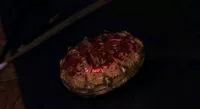The People in the Walls begins with such promise. A fairly fun ’80s-style synth track plays while the camera slowly zooms in on a cellphone displaying flickering analog TV-style static as a person’s voice, obscured by electrical vocal fry, screams seemingly in rhythm to the score. This creates a fun and unsettling combination of modern technology and retro distortion. The film then cuts to our first characters, two teenage girls, one of whom is clearly upset by something as they stand in front of her home, their dialog is oddly stilted and strange, which creates an off-putting and dreamlike atmosphere. When the titular people in the walls show up shortly thereafter, it’s a fun combination of intensity and silliness set to a thumping, humming score. I felt like I was in for a good time.
Unfortunately, first impressions aren’t everything. While there is an undeniable earnestness to this movie, most of it is half-baked at best, which is disappointing because there is a fun little horror movie hidden in there somewhere, like a cake that you know would be delicious but the egg is still raw.

The People in the Walls is a new horror movie directed by Michael Crum. It stars Mckenna Smith as Rachel and Natalia Santacoloma as Nancy, two teenage girls who quickly become friends based on their interest in the monsters. It also stars Donny Boaz and Cassi Colvin as Rachel’s parents.
When Rachel performs a new viral video craze that involves sitting in her darkened room and inviting “the people who live in the walls” to come out, she and her best friend are almost immediately attacked by monsters, some of which do look like people, and others are grotesque monsters. There is no ritual to call them forth, there is no key phrase, all that you need to do is tell the inhabitants behind your drywall that they can come out, and they do. At one point it is implied that they need a hole in a wall to exit, but at other points, they just come from shadows. One comes from the ceiling, which feels like cheating.
Logic is never likely in movies like this, and a strong sense of style and atmosphere can be more than enough to overcome even the silliest of premises. There is something genuinely scary about talking to the emptiness of a room in order to conjure something out of nothing. This is why Bloody Mary is so thrilling to children, why even as an adult, I wouldn’t say “Candyman” three times in an empty room. Our brains, I think, are so used to speaking as a form of communication with someone else that speaking to the emptiness gives us the feeling that someone, or something, is listening.
I can be a sucker for this kind of horror, and I’m very willing to overlook gaps in logic if the movie is otherwise effective. Still, one does want some kind of consistency, but the rules are never made clear, and they seem to constantly change. It seems that the wall-dwellers need darkened rooms to be able to come forth, but there are times when they clearly seem comfortable chasing characters through rooms with lights on. One of the characters has a toy light-up lightsaber that dispatches a monster at one point, but that weapon never seems useful outside of that one scene.

The People in the Walls has moments that almost work, despite the nonsensical plot, and these moments make the rest of it more frustrating as a result. It never capitalizes on what works, and more often than not completely changes direction for reasons that are unclear. At one point, Rachel and Nancy open books as they seem close to narrowing down what the nature of the monsters might be, presumably so that they can find a weakness. There is momentum here, and I wanted to see these girls learning about their tormentors so that they could fight back, but the movie drops this almost immediately to return to a series of chase scenes that make Scooby-Doo’s monster chases feel exciting.
Horror movies often live or die by the quality of the audio, and this movie lives by its sound design just long enough to die a tragic death. The sounds are this movie’s biggest strength and biggest weakness. The synth score is engaging and the atmospheric sounds, the occasional inexplicable screams, moans, hums, and growls, do most of the work in giving this movie whatever thrills it contains. Yet, the audio is so uneven as to seem unfinished. The dialog will go from crystal-clear to murky within the same take, sometimes people sound like they’re speaking into a tin can, or the air will create sound as it rustles against the microphone, obscuring what people are saying. Character’s voices will begin to sound like other people entirely. Perhaps this is why the actors seem to have been directed to scream at one another to show emotion.
Still, movies are primarily a visual art form, and there is an undeniable vision behind this movie. The sets are clearly made with care, and Michael Crum has an understanding of when and how to add visual tension with odd and interesting camera angles, often giving the impression of a malevolent presence in the rooms with the characters. Sometimes, however, this is thoughtlessly done, resulting in odd shots that obscure the action. When mixed with the often-haphazard editing and the often-strange line reads, this creates several unintentionally funny moments. At least it’s never boring.
Visually, the most interesting part of this movie are the few, brief shots of the monsters that hunt Rachel and her friends and family. I can’t say that the monster designs are good because I never get to see them for long enough to get much of an impression of what they look like. While this can effectively build tension and fear—after all, what we imagine is often scarier than what we can see—the rest of the movie needs to be stronger for that to work. A great monster could have helped salvage this movie. Instead, we get flashes of very inconsistent monster styles—some look just like bedraggled old people, some look vaguely like the creatures from The Descent, and at least one looks like a large, inexplicably grotesque version of the Raggedy Ann doll that Nancy’s grandmother holds earlier in the film. What this suggests about the nature of the “people” behind the walls, I have no idea.

The acting is weak, but the actors are earnestly giving their all with what they’ve been given. Even when the dialog is borderline incomprehensible, I felt for Rachel and her struggles. Some of the actors, Santacoloma and Boaz in particular seem to have a natural charisma. In a more carefully put together movie, I suspect that Santacoloma might be a genuinely captivating actor. Here, any charisma that seeps through the screen is despite the writing.
Given the premise, there was an opportunity to craft a movie that has something to say about our propensity to follow online trends, to explore how these trends push people into doing things that they otherwise wouldn’t, how the internet effectively invites unwanted guests into our homes in order to wreak havoc. Instead, it’s a movie that thinks it’s enough to show characters running up and down hallways.
By the end of the movie, when the director finally takes us someplace new, someplace seemingly akin to Stranger Things’ The Upside Down, everything becomes increasingly pointless and borderline humorously goofy. Because no clear rules or motivations have been established, the characters have nothing to do except run away from the monsters. There are no real stakes and nothing for the characters to work towards. By the end, one of the characters says “We didn’t do anything,” as if even the characters could tell what a pointless movie they’re in. I suppose they’re planning a sequel. There is some talent and passion fueling this movie, and I would truly like to see what Michael Crum would do with a smarter script, a sharper editor, and better microphones.





Love the review and thankyou for it . The monsters were vague on purpose. If a hole was in the house it meant the house was infected by these creatures. We had a budget of peanuts and crackerjacks so we tried not to get into a territory of explaining too much due to that fact. If it was enjoyed we planned on having more to expand on . We tried to make what seems like a long goosebumps or are you afraid of the dark episode .
Thanks again
Cool review. Well thought out and excellent wrting.
Although I agree with much of the review, particularly the wooden acting, especially Smith’s, I admit that the monsters actually scared me! They were just vague yet threatening enough to bring my mind back to things that scared me as a kid. I also loved the spunky, light-saber-weilsing boy! Now for the embarrassing part: the look of the monsters freaked me out so much that I had to stop watching it til later! Well-done P.S. What happened to the parents during all this?